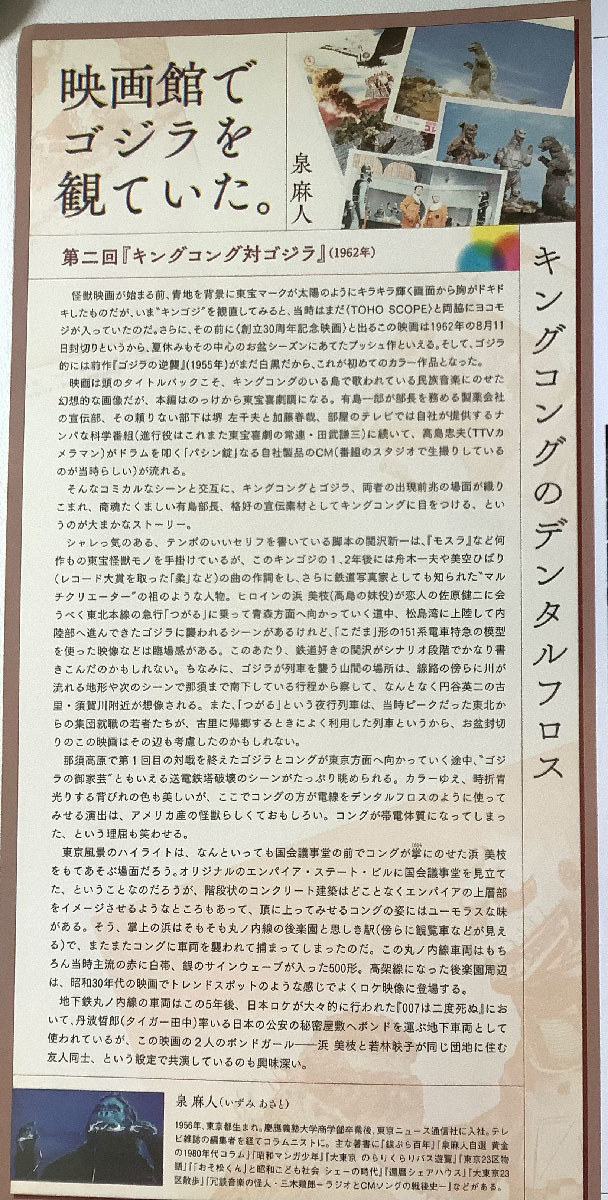5.13.2023
I was watching Godzilla at the cinema

映画館でゴジラを観ていた。
I was watching Godzilla at the cinema
泉麻人
Asato Izumi
キングコングのデンタルフロス
King Kong dental floss
第二回『キングコング対ゴジラ』(1962年)
The second movie “King Kong vs. Godzilla” (1962)
怪獣映画が始まる前、青地を背景に東宝マークが太陽のようにキラキラ輝く画面から胸がドキドキしたものだが、いま“キンゴジ”を観直してみると、当時はまだ
Before the start of the monster movie, my heart throbbed when I saw the Toho logo shining like the sun against the blue background. It contained yokomoji. Furthermore, since this movie, titled “30th Anniversary Commemorative Movie,” was released on August 11, 1962, it can be said that the summer vacation was a push for the Obon season. And since Godzilla’s previous work “Godzilla Raids Again” (1955) was still black and white, this was his first color work. The title background of the movie is a fantastic image on the folk music sung on the island where King Kong is, but the main part is in Toho comedy style from the beginning. Ichiro Arishima is the head of the publicity department of a pharmaceutical company. His unreliable subordinates are Sachio Sakai and Haruya Kato. Next, a commercial for the company’s own product called “Pashin Pill,” in which Tadao Takashima (TTV cameraman) plays the drums (it seems to have been filmed live in the studio of the program at that time) is played.
Yokomoji is horizontal script (esp. of a European language) (Source: Jisho.org https://jisho.org/search/yokomoji)
そんなコミカルなシーンと交互に、キングコングとゴジラ、両者の出現前兆の場面が織りこまれ、商魂たくましい有島部長、格好の宣伝素材としてキングコングに目をつける、というのが大まかなストーリー。
Alternately with such comical scenes, scenes that foreshadow the appearance of King Kong and Godzilla are interwoven, and the general story is that the strong commercial manager Arishima looks at King Kong as a suitable advertising material.
シャレっ気のある、テンポのいいセリフを書いている脚本の関沢新一は、『モスラ』など何作もの東宝怪獣モノを手掛けているが、このキンゴジの1、2年後には舟木一夫や美空ひばり(レコード大賞を取った「柔」など)の曲の作詞をし、さらに鉄道写真家としても知られた“マルチクリエーター”の祖のような人物。ヒロインの浜美枝(高島の妹役)が恋人の佐原健二に会うべく東北本線の急行「つがる」に乗って青森方面へ向かっていく道中、松島湾に上陸して内陸部へ進んできたゴジラに襲われるシーンがあるけれど、「こだま」形の151系電車特急の模型を使った映像などは臨場感がある。このあたり、鉄道好きの関沢がシナリオ段階でかなり書きこんだのかもしれない。ちなみに、ゴジラが列車を襲う山間の場所は、線路の傍らに川が流れる地形や次のシーンで那須まで南下している行程から察して、なんとなく円谷英二の古里・須賀川附近が想像される。また、「つがる」という夜行列車は、当時ピークだった東北からの集団就職の若者たちが、古里に帰郷するときによく利用した列車というから、お盆封切りのこの映画はその辺も考慮したのかもしれない。
The screenwriter, Shinichi Sekizawa, who writes funny and fast-paced lines, has worked on many Toho monsters such as “Mothra.” He wrote the lyrics for Hibari’s songs (such as “Soft,” which won the record award), and is also known as a railroad photographer. The heroine Hama Mie (Takashima’s younger sister) is on the Tohoku Main Line express “Tsugaru” heading for Aomori to meet her lover Kenji Sahara. There is a scene where they are attacked, but the images using a model of the 151 series train limited express in the shape of “Kodama” have a sense of realism. Sekizawa, who loves railways, may have written a lot about this at the scenario stage. By the way, the place in the mountains where Godzilla attacks the train can be imagined around Sukagawa, Eiji Tsuburaya’s hometown, judging from the topography where the river flows by the railroad tracks and the route southward to Nasu in the next scene. Also, the night train “Tsugaru” was often used by young people from the Tohoku region, who were at their peak at the time, when they returned to their hometowns to find jobs. unknown.
那須高原で第1回目の対戦を終えたゴジラとコングが東京方面へ向かっていく途中、“ゴジラの御家芸”ともいえる送電鉄塔破壊のシーンがたっぷり眺められる。カラーゆえ、時折青光りする背びれの色も美しいが、ここでコングの方が電線をデンタルフロスのように使ってみせる演出は、アメリカ産の怪獣らしくておもしろい。コングが帯電体質になってしまった、という理屈も笑わせる。
On the way to Tokyo, where Godzilla and Kong have finished their first battle at Nasukogen, you can see the scene of the power transmission tower destruction, which can be said to be “Godzilla’s specialty.” Because of the color, the color of the dorsal fin that sometimes shines blue is also beautiful, but here, Kong’s production of using electric wires like dental floss is like an American monster and is interesting. The theory that Kong has become electrified makes me laugh.
東京風景のハイライトは、なんといっても国会議事堂の前でコングが掌にのせた浜美枝 をもてあそぶ場面だろう。 オリジナルのエンパイアステートビルに国会議事堂を見立て た、ということなのだろうが、 階段状のコンクリート建築はどことなくエンパイアの上層部 をイメージさせるようなところもあって、頂に上ってみせるコングの姿にはユーモラスな味 がある。 そう、掌上の浜はそもそも丸ノ内線の後楽園と思しき駅 (傍らに観覧車などが見え る)で、またまたコングに車両を襲われて捕まってしまったのだ。この丸ノ内線車両はもち ろん当時主流の赤に白帯、 銀のサインウェーブが入った500形。 高架線になった後楽園周辺 は、昭和30年代の映画でトレンドスポットのような感じでよくロケ映像に登場する。
The highlight of the Tokyo landscape is undoubtedly the scene in front of the Diet building where Kong plays with Mie Hama on his palm. It may be that the original Empire State Building was modeled after the Capitol, but the stepped concrete architecture somehow reminds us of the upper part of the Empire, and the figure of Kong climbing to the top has a humorous flavor. Yes, [this] was originally a station on the Marunouchi Line that I thought was Korakuen (a Ferris wheel can be seen beside it), and Kong attacked the car again and got caught. This Marunouchi line car is a 500 type with red, white belt and silver sine wave, which was the mainstream at that time. The area around Korakuen, which has become an elevated railway line, often appears in location footage as a trendy spot in movies from the 1950s.
地下鉄丸ノ内線の車両はこの5年後、 日本ロケが大々的に行われた 『007は二度死ぬ』にお いて、丹波哲郎 (タイガー田中)率いる日本の公安の秘密屋敷へボンドを運ぶ地下車両として 使われているが、 この映画の2人のボンドガール浜美枝と若林映子が同じ団地に住む 友人同士、という設定で共演しているのも興味深い。
Five years later, the train on the Marunouchi Subway Line was used as an underground vehicle to transport Bond to the secret mansion of Japanese public security led by Tetsuro Tanba (Tiger Tanaka) in the movie “You Only Live Twice,” which was filmed on a large scale in Japan. Although it is used, it is also interesting that the two Bond girls in this film, Mie Hama and Eiko Wakabayashi, co-star as friends living in the same housing complex.
泉麻人(いずみあさと)
Asato Izumi
1956年、東京都生まれ。 慶應義塾大学商学部卒業後、 東京ニュース通信社に入社。 テレビ雑誌の編集者を経てコラムニストに。 主な著書に『銀ぶら百年』 『泉麻人自選 黄金 の1980年代コラム』 『昭和マンガ少年』 『大東京のらりくらりバス遊覧』 『東京23区物 語』 『 「おそ松くん」 と昭和こども社会 シェーの時代』 『還暦シェアハウス』 『大東京23 区散歩』 『冗談音楽の怪人・三木鶏郎ーラジオとCMソングの戦後史ー』などがある。
Born in Tokyo in 1956. After he graduated from Keio University Faculty of Commerce, he joined Tokyo News Service. After working as an editor for a television magazine, he became a columnist. His major publications include Ginbura 100 Years, Asato Izumi’s Self-Selected Golden 1980s Column, Showa Manga Shonen, Rari Kurari Bus Excursion in Greater Tokyo, Tokyo 23 Wards Monogatari, Osomatsu-kun and Showa Children’s Society, Shea’s Era. “60th Birthday Share House” “Great Tokyo 23 Ward Walk” “Joking Music Phantom Miki Torro – Postwar History of Radio and CM Songs.”